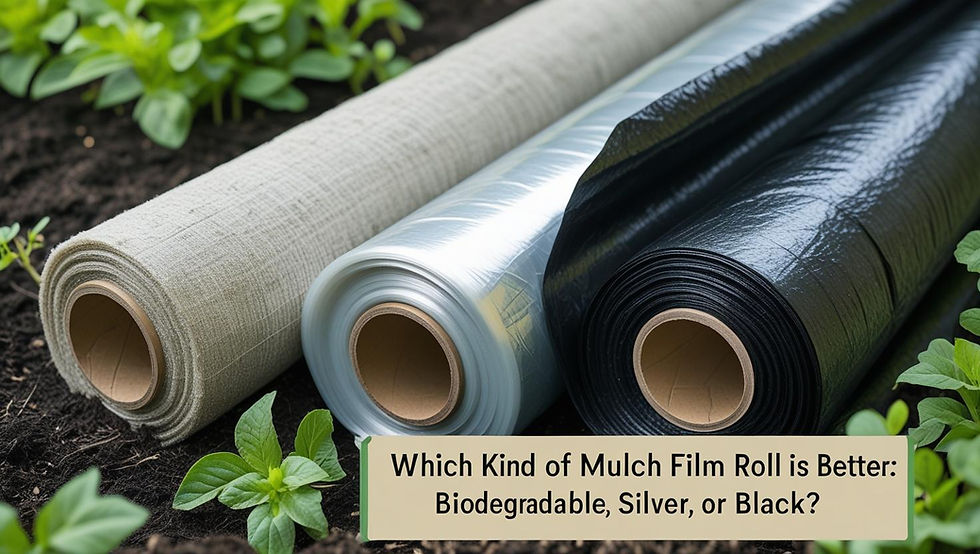How Do Temporary and Permanent Protective Films Differ for Stainless Steel Appliances?
- Rahul Solanki
- Aug 1
- 4 min read

Introduction
Stainless steel appliances are renowned for their durability and streamlined design in both residential and commercial settings. These surfaces are susceptible to dust, fingerprints, scratches, and mild corrosion, though. Because of this, surface protection is crucial for long-term use in certain situations as well as for transportation and installation. Using protective film for stainless steel appliances is one of the best ways to preserve these surfaces. By acting as a barrier, protective films guarantee that appliances stay in perfect condition for the duration of their lives.
It's interesting to note that the agricultural industry has a parallel. Similar engineered films are produced by agricultural film manufacturers to protect crops and soil, demonstrating a common emphasis on material durability and protection.
What Is Protective Film for Stainless Steel Appliances?
Definition and Purpose
Applied directly to metal surfaces, protective film for stainless steel appliances is a specially made adhesive-backed film. Among its primary duties are:
Protecting against scratches, scuffs, and minor dents.
Shielding from dust, dirt, and environmental contaminants.
Reducing fingerprints and maintaining a polished appearance.
Offering mild corrosion resistance during storage or transit.
Where It’s Commonly Used
Kitchen Appliances
Protective films are widely applied to:
Refrigerators
Ovens
Dishwashers
Microwaves
Industrial Equipment with Stainless Steel Finishes
Protective films help preserve the quality and functionality of stainless steel parts used in manufacturing and industrial settings, including control panels, machinery casings, and storage units.
Difference Between Temporary and Permanent Protective Films
Adhesive Strength
Temporary Films
Adhesive Type: Light to medium tack adhesives that stick securely but allow for easy removal.
Purpose: Protect surfaces during short-term events like shipping, storage, and installation.
Residue: Designed for clean removal, leaving no adhesive residue on the surface.
Permanent Films
Adhesive Type: Strong, long-lasting adhesive meant to stay in place for years.
Purpose: Used for long-term protection in high-traffic or industrial environments.
Residue: May leave adhesive traces when removed, especially if not designed for residue-free removal.
Material Composition
Temporary Protective Films
Common Materials: Polyethylene (PE), Polyvinyl Chloride (PVC), or Polyester (PET).
Characteristics:
Thin yet durable.
UV-resistant and scratch-resistant.
Easy to cut and apply.
Permanent Protective Films
Common Materials: Thicker variants of PVC, PET, or specialty engineered polymers.
Characteristics:
Enhanced chemical and wear resistance.
Higher thickness for better impact protection.
May include additional coatings for anti-graffiti or anti-bacterial properties.
Application Scenarios
Temporary Film
Appliance transportation and storage.
Retail showroom display units.
Short-term renovation projects.
Permanent Film
Industrial machinery exposed to harsh conditions.
Architectural stainless steel installations, such as elevator panels.
Long-term protective needs where frequent cleaning or high traffic could damage surfaces.
Insights from Agricultural Film Manufacturers
Similarities in Material Engineering
Both protective films for stainless steel appliances and agricultural films share several engineered qualities:
Durability: Both need to withstand external stressors like UV exposure and temperature fluctuations.
Material Flexibility: Polyethylene and similar polymers are commonly used.
Protection Focus: While purposes differ, both prioritize maintaining surface integrity.
Differences in Purpose
Protective Film for Stainless Steel Appliances
Primary Function: Surface aesthetic and scratch protection.
End Use: Appliances, architectural elements, industrial equipment.
Agricultural Film Manufacturers’ Focus
Primary Function: Supporting crop growth.
End Use: Soil moisture retention, weed control, climate regulation.
Despite these differences, both industries leverage similar plastic film technologies to protect valuable surfaces or materials.
How to Choose Between Temporary and Permanent Protective Film
Factors to Consider
Appliance Usage and Environment
Home Appliances: Temporary films usually suffice.
Commercial Kitchens or Industrial Environments: Permanent films offer longer-lasting protection.
Cost vs. Protection Level
Temporary Films: Lower cost, suitable for shorter-term needs.
Permanent Films: Higher initial cost but longer service life.
Manufacturer Reputation and Product Testing
Always look for:
Proven track record in supplying protective films.
Technical datasheets and third-party testing certifications.
Customization options for film size, adhesive type, and thickness.
Supplier Quality Check
When comparing suppliers—whether for appliance protective films or agricultural films—check for:
ISO certifications.
Customer reviews and case studies.
Availability of sample products before bulk ordering.
FAQs
Can Temporary Protective Film Be Reused?
Temporary protective film is typically not made to be reused. Reapplication is useless because the adhesive loses strength once it is removed. Nonetheless, under carefully monitored circumstances, certain premium films might permit limited reuse.
How Long Does Permanent Film Last on Stainless Steel Appliances?
Permanent protective films can last:
3–7 years on average, depending on environmental exposure.
Some products are rated for up to 10 years in specific conditions like interior applications with minimal UV exposure.
What Are the Environmental Considerations for Both Types of Films?
Recyclability: Many polyethylene-based films are recyclable.
Biodegradability: Rare for protective films, but some eco-friendly options are emerging.
Disposal: Always follow local recycling and waste management regulations.
Similar environmental scrutiny is applied to agricultural films, which spurs innovation in the form of recyclable plastic alternatives and biodegradable mulch films.
Conclusion
Depending on your particular application, usage environment, and financial constraints, you can choose between temporary and permanent protective films for stainless steel appliances.
Key Differences Recap:
Temporary Protective Film: Best for transportation, short-term storage, and retail displays. Easy to remove without residue.
Permanent Protective Film: Ideal for industrial or high-traffic applications where long-term surface protection is essential.
It's also important to note how agricultural film manufacturers share material technology. Both industries concentrate on creating cutting-edge plastic films that strike a balance between environmental responsibility, flexibility, and durability.
Final Advice: When selecting a protective film, always:
Review product specifications.
Confirm supplier certifications.
Consider the total cost of ownership, not just the upfront price.
For More Information Visit: Tilak Poly pack Pvt.Ltd



Comments